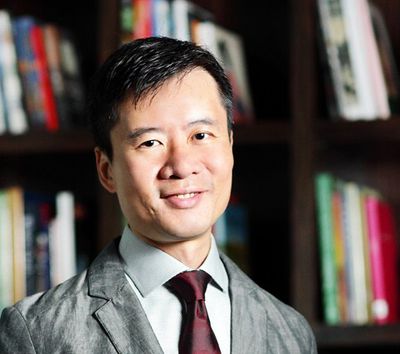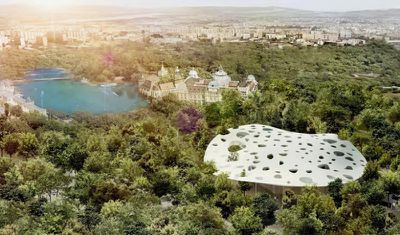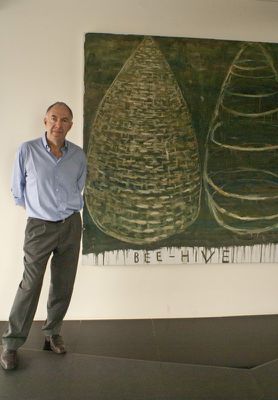17 Nov 2014
The National Gallery Singapore | A Conversation with Jean-François Milou

Photo credit: Fernando Javier Urquijo, studioMilou Singapore[/caption]
A French architectural firm, with branches in Paris and Singapore, studioMilou specialises in the design of museums and cultural spaces. Led by principal architect and lead partner Jean-Francois Milou, the firm works with adaptive reuse of historical buildings, seeking imaginative solutions while respecting the building's historical fabric, meaning and surroundings.
Among a number of prestigious undertakings, Jean-François Milou has worked as a consultant to UNESCO, and for the French Government on projects in India, Nepal, Indonesia and Georgia.
studioMilou beat out 110 entries in winning the competition to design the National Gallery Singapore (due to open in 2015 for the 50th Anniversary of the independence of Singapore). Singapore's latest institution will host the National Heritage Board Collection of Modern Southeast Asian art within iconic architectural structures - former City Hall and Supreme Court building - that embody the colonial history and heritage of Singapore. These once intimidating edifices will for the first time allow its public free access when launched as a National Gallery for Modern Art in 2015.
Art Critic Bharti Lalwani finds out more about the aesthetic direction of this new institution.
(Key- Jean-François Milou: JFM, Bharti Lalwani: BL)
BL: Unlike new museums that are built from scratch, studioMilou is converting existing heritage buildings into a museum for Modern and Contemporary art from Southeast Asia (SEA). Jean-François, let us begin with your strategic plan for the architecture of the National Gallery Singapore (NGS).
JFM: Most of the galleries and museums built today, if not all, are built from scratch, often as iconic free standing landmarks, which in some cases lack real attention to existing contexts and landscapes.
Singapore is making a strong statement in reusing two major national monuments to create this visual art institution, or let’s say to grow an art institution from an existing and significant historic and cultural landscape: the former City Hall and the former Supreme Court of Singapore. This decision to reuse the two buildings has been criticised by some, but I believe it is a chance to grow something more organic from a real and complex existing fabric of culture, spaces and information. This necessary negotiation between the architecture, the collection, the curatorial discourse and the city as it is seems to me, is more interesting.
To answer your question, my position as the architect is to create a building which does not compromise on quality down to the smallest details, or on what a national institution of this status should be with respect to its facilities and to the complex historical fabric of the two buildings.
The two layers of design - the Gallery and the monuments - are merging in a new architectural landscape, one that is peaceful, even, flowing in natural light. We hope to create an environment where people of Singapore and museum goers from further afield will experience sufficient sense of calm while mediating the architecture and the collection. In order to accomplish this, I have given priority to a sense of unity as compared to juxtapositions, to an elegant backdrop filled with natural light and designed to accommodate what will be an evolving institution with multiple configurations for exhibitions and events.
BL: Could you provide specifics of the architectural accentuation?
JFM: Yes, the surface area of the new institution will be 60,000m2, with a budget of around 500 million Singapore dollars. We are joining these two buildings via a new roof structure, a kind of veil that seems to float above the roof level of the two independent structures. This complex draping glass-and-steel structure will filter the intense light of Singapore and create new spaces bathed in natural light. This is designed in such a way that it complements the system of levels of the façades of the former Supreme Court and City Hall buildings.
So on one hand it is a very ambitious architectural project of creating new entrances, new roof top piazzas under a complex and sophisticated fabric of metal and glass, while on the other, it is a very respectful and modest restoration of two existing historical buildings. Hopefully people of Singapore will have the impression that the existing building have been returned with minimal intervention, recognizable yet modern.
BL: But as they are steeped in Singapore's colonial history, how do you intend to transform and shape our experience of these imposing structures as sites of contemplation for art, while keeping the integrity of the building exteriors intact?
JFM: Again, the project will conserve much of the existing structure, which consists of many different spaces, some very large, some very small, some designed as simple white boxes and some more as heavily decorated historical spaces. This succession of different spaces of diverse character will create options for varied curatorial approaches. This variation of spaces (scale, character, etc.) can as well be a way to reflect the various contexts of South-East Asian art if sensitively treated in relation to the art displayed. But as just mentioned in replying to your question above, the unity of the design approach within the interiors – to be given in particular through the use of limited materials and colour schemes – will be one of the main ways the design creates spaces which are in many instances conducive to contemplation. And, the roofing structure, a filigree metal form draping gently over the buildings, is also designed to filter the light and create a gentler interior whereby the sunlight itself gives a sense of continuity between the two buildings, and softer ambiance.
There is minimal impact on the architecture of the two buildings which includes a rooftop landscape composed of areas open to visitors and new walkways between the buildings. As such, it radically changes the circulation and allows visitors new perspectives. The competition jury particularly appreciated this elegant aspect of our design and how it could radically transform the visitor experience while changing very little in the buildings themselves.
Speaking more specifically about individual spaces, that requires the curators acknowledging the character of each space and feeling confident enough to play with the dense wood panelling in some of the rooms, the white walls in others, all with full respect for their significance for the public. By taking on this variation, which reflects more about the original structures than anything else, the Gallery can create an interesting visitor experience blending the collection, the buildings and the cityscape.
BL: You have reinvigorated some century old buildings in Europe, the most recent being the Carreau du Temple in Paris. The two heritage buildings of Singapore are nearly as old. Are there certain structural issues (exterior and interior) when dealing with such sites?
JFM: Yes, many, and studioMilou’s teams in Paris and Singapore have always taken an approach that tends to share something of a researcher’s intensive interest and an artisan’s intimate concern when it comes to the restoration and adaptive reuse of buildings.
When dealing with heritage and existing buildings, architects have to spend a lot of time not only researching and exploring solutions which avoid ‘harming’ buildings, but also explaining their approach to their client whilst convincing them, or the partners of the project, or the agencies about design decision here and there. This process reflects the expectation of the civil society when it comes to the conservation of important historical monument.
One of the main challenges is to incorporate the requirements for new modern exhibitions and performances (security, fire safety, climate control, etc.) in a traditional building without compromising the integrity and the authenticity of the building itself.
Additionally, all rooms are different with different settlements, so each room, each door, each window is a small project in itself. Part of the work almost involves being a bit like an archaeologist, and part of the work is to be an architect. It takes time.
With each project, our firm has sought to go beyond the notion of pure conservation, instead striving to offer solutions that combine our conservation skills and practices with practical and contemporary architectural approaches inspired by the reality of places and the circumstances of the projects themselves. Le Carreau du Temple, recently open in Paris, and the National Art Gallery Singapore bear witness to this approach whereby we endeavour to respect the original buildings while offering contemporary solutions in terms of ideas and influences.
"when it comes to responding to the collection, programmes
and curatorship, the Architect should be a good listener,
and should create an efficient, inspiring and beautiful museum
infrastructure able to accommodate the many new ideas,
initiatives and changes to come"
BL: A National Gallery dedicated to Modern art from the region is a first for Southeast Asia; naturally, its museum-professionals are young in the field and somewhat inexperienced in dealing with such an ambitious project. I believe the government collection too is not enough to fill the combined 60,000 sqm space of the two buildings. What are your challenges then in anticipating their needs?
JFM: The 60,000 sqm includes the exhibitions, public spaces and numerous back of house areas for storage, delivery, and moving exhibitions, and food and beverage, etc. When it comes to galleries created recently almost from scratch, as those built in the past decade in Australia (Goma, Mona, etc.), I think it’s fair to expect that for some time the Gallery will be an institution firming up its identity and directions, a gallery in progress, with a collection in progress, a discourse in progress and so on.
But when it comes to responding to the collection, programmes and curatorship, the Architect should be a good listener, and should create an efficient, inspiring and beautiful museum infrastructure able to accommodate the many new ideas, initiatives and changes to come (new art pieces, new curatorships and such). I think this is part of the brief to a large extent in most new-born galleries. I would say that the Gallery is positioning itself as an institution with the potential to evolve overtime, building its collections as it goes.
BL: If South East Asian art professionals are at a nascent stage, its museum/gallery-going audiences are even younger. Singapore's "mall culture" is well known and the general attempt in the case of Singapore's Gillman Barracks (a colonial barracks transformed into a gallery hub) has been to transplant that experience by fitting in commercial and F & B outlets to encourage visitor-ship. I gather that 7 commercial outlets are planned in NGS. What types of outlets are these and will this extra-ordinarily high number of shops (for any museum) distract from the museum's viewing experience?
JFM: The National Gallery Singapore needs balance being a site that its local populations can relate to – especially in its opening years - and a site that is of great interest and credibility to visitors from further afield. The Gallery will include a strong commercial element and this is part of the broader cultural way of doing things in general, notably when seeking to attract family groups, which will often prefer the option of stopping to eat, particularly if older and younger family members are involved.
We know that for some, pushing the door of an art institution of this magnitude and ambition in Singapore may initially be intimidating and unfamiliar. For this reason, a part of our brief is clear about the need to create an institution which is welcoming for all the people of Singapore, which encourages them to step into the buildings. For many, the initial reasons for stepping into the institution will be curiosity about the buildings and their new functions (which isn't unexpected given the importance of the monuments), and this may well involve an outing where they look at the art, stop for a rest, to eat, to shop. This mix-use strategy is more and more common in Galleries worldwide, and is in many cases, a strategy for balancing the revenue: State and private.
So the gallery proposes to mix exhibition, programming and public spaces with gardens, with cafes/restaurants and book stores. Just how the commercial side of things play out in this regard, balancing the attention of visitors, will depend on the quality of the institution’s core functions – displaying artworks, creating public programmes/ dialogues across cultures and such. These core aspects need to be strong enough to dominate other facets. There is a risk of blurring the boundaries between the institution being known for its art or being known primarily for its commercial attractions of so-called ‘lifestyle’ or recreational zones. The designer should pay attention to clearly separate the zones of the gallery in order to not create any overlapping or confusion between the meditative and reflective experience in the collection and the entertaining experience of the F&B and shops.
Again, this is a distinct red line that many major art institutions have to draw. We have designed the space by planning for retail outlets in the overall Gallery plan with this well-defined red line in mind.
Also about the National Art Gallery Singapore:
The National Gallery Singapore | A conversation with Low Sze Wee
Links:
Bharti Lalwani is an art critic who contributes to The Art Newspaper, Harper’s Bazaar Art Arabia, Eyeline (Australia), among others. Her research interests include Private museums as well as contemporary art from Southeast Asia, the Middle-East and West Africa. Through her writing and research she connects the emerging contemporary art histories of three continents. In 2014, she was nominated Forbes Art Writer of the Year (India).
Similar content
posted on
14 Aug 2014
posted on
16 Feb 2015
posted on
15 May 2018
posted on
02 May 2011
posted on
11 Oct 2010
posted on
17 Oct 2011





